Community Essay : Living Under ‘a Veil of Denial’ : Bias: Only by recognition and understanding can the racism in all of us be overcome. Truth is the healthiest condition.
- Share via
Stacy Koon, one of the officers involved in the Rodney King beating case, referred to King as “Mandingo” and feared him because he is black, but insists he is “not a racist.” My students, in post-unrest discussions, framed their comments with the tired “I’m not a racist but . . . “ and my colleagues bend over backward trying to show me how liberal they are. No one, it seems, wants to admit to our country’s deeply racist roots.
America’s denial of its racism is tantamount to an alcoholic refuting his illness. And like an addict, if my students, city or country continues to insist on being “colorblind” or judging all people by the content of their character, then the specter of racism will continue to rear its terrifying head.
To belie my own racism would be quite easy. I worked in Watts for 8 1/2 years; I even asked the school district to place me there. I also hail from an oppressed minority--Mexican-American--and suffered discrimination. In fact, I even remember being called a n----- during my formative years in Glendale. My chess-playing buddies Gene, Eddie, Vince and Charlie are all, like my wife, African-American. So how could I possibly be prejudiced or racist? Shall I bend my back some more?
Despite my race-relations credentials, none of these particulars, whether isolated or bunched together, can stand up to one undeniable fact: I am an American, born and raised. To be an American is to be racist. Anyone can see this, with their eyes closed--or can they?
After a few years of teaching in Watts, I developed a keener insight into the dynamics of racism or, as Malcolm X called it, Americanism. In supermarkets, I noticed the images of wealth, beauty, happiness and success in the magazines at the checkout stands. With the exception of sports magazines, where a few African-Americans--namely Michael (Jordan) and Magic (Johnson)--dominated the covers, I realized that blacks, Latinos or Asians rarely achieved front-page status. The print media’s message rings loud and clear: Success is fair skin, blue eyes and a European figure. No African butts, slanted eyes or greasy hair allowed. My awareness didn’t stop there. Billboards, radio and television all spoke the same message every day, “If it’s dark or foreign, you’re not welcome in the glamour of America’s home.” Even trying to find solace in a pool hall, I discovered that the eight ball, the darkest ball in the rack, was the last to go in the pocket, leaving only the white ball to roam the green felt.
I asked my students how they could watch television and not be insulted by the images that brainwashed them. Outraged by such a claim, they balked. So, to prove my point, I asked the males in my class, “What’s the first thing you guys do when you’re together discussing a ‘freak’ or a ‘fox?’ You ask, ‘Hey, what she look like? . . . Oh, man! She’s real fine, man. She’s light-skinned,’ ” at which the class got quiet and smiled. Then a young girl said, “He’s right . . . “ while the rest of the students giggled, easing the embarrassment of being “moded.”
Awareness of my Eurocentric society made me realize how my own attitudes shaped my preferences. As a child, I proudly announced to my older sister that my choice of girlfriend, when I got old enough, would be blond and blue-eyed. And through my formative years I would constantly look in the mirror, dreaming of blond locks and a surfer face, something I couldn’t readily describe but tangible enough for me to know I didn’t possess.
Walking among my students in Watts, exposed to a people from whom I’d been sheltered, I viewed American society in a different light. I started asking questions. Who had kept this rich, beautiful African-American culture from my consciousness? Why had I never even thought of my own Latinas as gorgeous or goddess-like? And why weren’t these the faces that spill out on the pages of magazines or the myriad television commercials that ingrain our preferences and desires? But despite these questions and revelations, I realized how much of America I personally swallowed.
Like a fugue in a G minor, my own Americanism played itself out in a variety of ways. There were the obvious ones: confusing two people for the same one, assuming two black people knew each other or believing that all of my African-American colleagues shared the same political ideology. In addition, the liberal paternalism with which my mother raised me--the “Oh, these poor black people have had such a hard life,” attitude--prevailed not only in me, but in many of my white colleagues. In class I would often accuse students of stealing my things only to find out I had merely misplaced them. And in college, I manifested a superiority over my own Mexican people. Apparently, I believed the constant refrain my Anglo friends intoned: “You’re Mexican, but not really.” As one of my African-American teammates pointed out, “You think you’re better than me.”
These attitudes and beliefs, since changed, nonetheless existed, a part of my upbringing that subconsciously incorporated itself into my American psyche. Upon reflection of this American culture and my own experience in the inner city, I realized how incredibly powerful this disease is that brainwashed me, and how tightly its insidious grip steers the conscious and subconscious behavior of most citizens in this country.
While my experiences may be unique, the outcome--my being made aware of and sensitive to the racist world I live in--should not.
Anyone willing to question themselves and the system in which we live will hopefully come to one conclusion--the truth; much better than the current veil of denial under which most Americans live.
More to Read
Sign up for Essential California
The most important California stories and recommendations in your inbox every morning.
You may occasionally receive promotional content from the Los Angeles Times.













